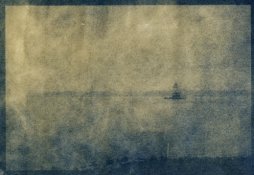Hi all!
I am getting ready to dive into cyanotype and Van Dyke processes. I've been reading and gathering information on every aspect, but the one area that still has me confused is the negative.
I've read some use digital prints on transparency paper, but can you create a negative in photoshop and print it on matte paper or photopaper and get good results? Also, when putting the negative on the treated paper in the contact frame, what is the correct placement? Treated paper-then negative (face down or face up)...towards glass?
Appreciate all thoughts and comments!
J~
hi pkarmatic
i have gotten OK results for printing cyanotype negatives on xerox paper, never done VDB
i followed the instructions made by someone on flickr
https://www.flickr.com/groups/61907246@N00/discuss/72157624882653671/
the link i included has a set of videos that show how its done.
with regards to placement ...
flip your negative when you print it ( using whatever negative you want )
i uploaded a cyanotype i made this way ... its printed on something about 8x10
the colors aren't blue because i bleachback and paint my cyanotypes.
i can't remember the time it took to expose, it was winter and there was a lot of reflected UV from
the snow on a sunny day ... i've printed a lot of things this way as a cyanotype using paper negatives
++ added later ++
i have also made hand coated paper negatives ( on something like butcher's paper )
using liquid emulsion, and coating it the same way with wax. i'd suggest RC paper too but sometimes
it takes too long for the light to pass through ( even waxed ) rc paper and some have writing on the reverse
and there are very few if any sw fiber papers around and regular weight fiber paper waxes easy,
but still is thick, maybe will take a long time to make a cyanotype &c.
to get a paper negative you enlarge to whatever size you want and make a
print ( positive ), and make a contact print of that image onto a 2nd sheet of paper, like you would with film
making a contact sheet. you can get both sheets of paper wet put them together and squeegee the water out of them on a
piece of glass to assure a tight seal ... waxing the paper makes a little more see-through to transmit light
but it isn't necessary in the darkroom unless you just want to do it ...
butcher's paper is thin, coats easy and waxes easy and doesn't curl but any photo paper will do, and can be turned into a negative easily
and printed through as a cyanotype if you don't want to deal with a xerox machine or any other modern technology ....
good luck !







